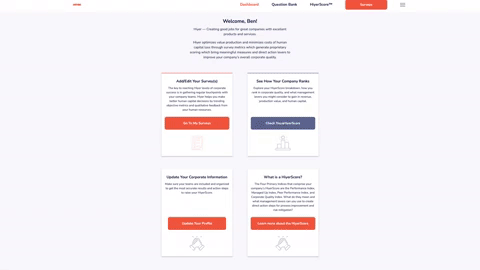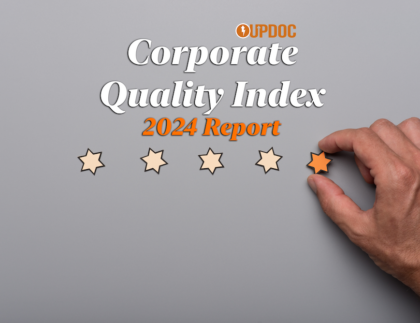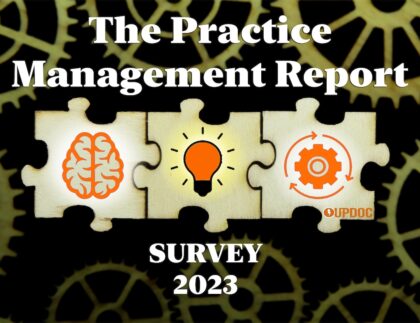
1. 41% Of Employees To Walk Out On Employers In 2024
Buckle up, 2024 is more than likely to witness a mass exodus if organizations do NOT make strong changes in directions of trust and professional development. That, however, is the good news — we’ve learned through the Corporate Quality Index at UpDoc, that trust fuels engagement.
While the global standpoint is that 41% of employees are waiting in the wings to leave, for physical therapy as an industry, we beat them out by 1% at 42% of the workforce with intentions to leave (Corporate Quality Index Report 2023).
What are they looking for? What will stop this 40+% exodus? Physical therapy professionals are looking for what everyone is looking for:
- Career advancement
- Better pay
- Improved workplace environment
- A favorable workplace culture
- And, they want to be able to trust their employers — specifically their managers.
The good news is that nearly 50% of factors which can cause an employee in physical therapy to stay are NON-FINANCIALLY MOTIVATED factors. Please see the 2023 Talent Acquisition and Retention Report.
2. Trust Creates 260% More Motivation To Work
Trust begins with “Hello.” We know from the Talent Acquisition and Retention Report from this year that applicants have a high level of skepticism about the honesty and accuracy of employer job posts. Whether it is the description, the roles and responsibilities, the locations, the set hours, and/or the pay scale — there’s been enough emotional whiplash experienced by applicants that many are now skipping out on finishing applications all together — they start, the stop, they leave. We’ll dive into that in a later stat.
All said, since inception, only about 30% of the workforce can meaningfully state they trust their employers in being a Responsible Corporate Citizen (Corporate Quality Index Report 2023). We know from both UpDoc as well as the plethora of business management and workforce intelligence literature that trust is a critical driver of engagement.
Beyond this, the macro economic considerations are staggering.
“Trusting employees are 260% more motivated to work, have 41% lower rates of absenteeism, and are 50% less likely to look for another job. But consider this: We also found that roughly 1 in 4 workers don’t trust their employer. At the same time, most employers overestimate their workforce’s trust level by almost 40%. With this misalignment in trust, it’s no wonder that worker engagement is suffering.” (Sloan MIT January 2023)
So, let’s ask the question: How much do your employees actually trust you?
The Answer: You have to ask. And, what better way than a tokenized, secure workforce engagement platform such as HIYER by UpDoc, Inc.?
3. Only 2% of the Talent Would Leave You For Greener Pastures
Per our Talent Acquisition and Retention Report, only 2% of the workforce would leave their current role for a better opportunity elsewhere. There’s a lot managers can do with this at all levels. Overall, we know between all the 2023 industry reports at UpDoc from last year that the talent isn’t exactly hunting around for better jobs per se. They are where they are, they want to belong where they are, they wish to be appreciated, recognized, paid better, and give more autonomy to their clinical craft.
All together, along with trust, our talent in physical therapy and rehab therapy at large wishes to be engaged in all those ways above — fully defined and not exactly a secret.
The benefit? You Can Reduce Almost 60% Turnovers Through Engagement.
Once again, consider this macro view of what can be achieved via Gallup.
Engaged organizations see 59% less employee turnover. (Gallup, 2022)
- When employees are engaged, they’re more likely to remain loyal to their organization. This highlights the importance of fostering a work environment where employees feel connected, valued, and motivated.
- 63.3% of companies say retaining employees is actually harder than hiring them. (Zenefits, 2019)
- Retention challenges show the importance of not just attracting talent, but also creating an environment where they want to stay.
- This is a bit of a flip for healthcare as most hiring managers would say that retention isn’t the challenge as much as new hiring is.
That said, this may be a discussion of the chicken and the egg as we laid out in the Corporate Quality Podcast, 2023 Practice Management Report mini-series.
4. 80% of the Workforce Says Mediocrity is Tolerated… Even REWARDED
The Corporate Quality Index Report has covered this key index item in detail since inception. Sadly, it seems as much as quality and excellence are touted tenants of our profession, it also seems that mediocrity is not so secretly snuck in there… tolerated… and, many times rewarded.
There is so much to discuss on this point a la our episode in the Corporate Quality Podcast; often including the effect that those who “don’t rock the boat” tend to be the ones promoted — those movers and shakers, usually punished (passively, or otherwise)... turning over after burning out shortly thereafter.
What does all this mean? One thing: Employees want their managers to LEAD BY EXAMPLE.


5. Agile Companies are 72% BETTER at Promoting Ownership Mindset
On top of that, agile companies (who are mostly represented by smaller work scales such as small business) are also 50% better at properly managing mediocrity.
All said, the practice behaviors of small business style employers in physical therapy is leading the way. As a whole, we need to master agility and responsiveness; it projects that management is for real, they care, they are authentic, and are trustworthy — there’s that word again… TRUST.
It’s easy to get lost within the corporate mixture; while there are successful entities performing well on the trust and authenticity side of life, this is rather the exception to the norm when compared to how well small business is doing overall in this arena.
As much as this might be a humble brag by small business operators, what we may actually be seeing is a management principle in play: Span of Control. This is covered in depth in both the 2023 Corporate Quality Index as well as the Span of Control episode of the Corporate Quality Podcast.
All said, there seems to be a necessary review of management structure; it’s a great opportunity to streamline career growth tracks as much as it is to promote autonomy, team engagement, and workforce buy-in.
6. 90% of Employers Struggle with Resignation, New Hiring, or BOTH
One of the greatest struggles moving into 2024 identified by practice managers is that of human resources. Talent acquisition and retention is the number one blocker of company growth.
For further numerical reference:
- Over 76% of hiring managers are actively recruiting, however with little to no positive gains.
- Only 20% of the workforce seems to be truly satisfied with their current job.
- Much of the workforce would stay or leave based on NON-MONETARY factors of the workplace.
There even exists a minority report of 3% of employers who state they have no problems hiring new people… they just can’t seem to keep them.
We’ve experienced and continue to be embedded in a new wave of workplace cultural expectations. Some of it aligns with the realities of healthcare, while some of it requires a reality check. Nevertheless, the only real solution sets come from BOTH employees and employers seeking out a “WE” path forward rather than a “you versus me.”
7. Only 7% of Managers Who Turnover List Pay As a Reason For Leaving
Employee Experience MATTERS At ALL Levels. Our 2023 Talent Report highlighted that when it comes to turnover, only 7% of managers mentioned that they weren’t being paid enough as a reason for leaving.
It should also be of high interest to hiring managers that only 2% of talent respondents stated they would leave due to a better opportunity elsewhere (previously mentioned above).
In fact, there exists a listed top 7 reasons in this report that summed at 80% of the overlapping reasons for the talent pool to make the decision to leave. Of course, “bad management” was at the top and makes talent turnover faster than anything.
Still, when you throw in everything outside of addressing inadequate compensation and questionable/unethical practices in business or clinical care — you’ve removed 61% of the reasons talent might leave.
Our recommendation given these statistical notes is this: CAREFULLY AUDIT YOUR MANAGEMENT PROCESSES.
This should include the training, dashboard metrics, accountability, and trust factors of line, middle, and upper management. As a bonus stat to this: During the release of the 2023 talent report, only 20% of the line staff workforce is happy enough to stay put. However, 50% of managerial staff is satisfied and is not actively looking for their next opportunity.
Given that Q4 tends to be the highest turnover span of time and Q1 tends to be the highest hiring phase of the year, it’s safe to say this is a good time to make 2024’s Q4 your best record in talent retention… at ALL levels of your company.

8. Lack of Transparency totals 58% of the Reasons Your Job Postings Are IGNORED
Transparency is trust. While the term, similar to corporate social responsibility, tends to be subjective and self defined in the eye of the beholder – it doesn’t take away from the fact that human resources are ultimately HUMAN. We need to respect the integral need of people and the desire to work for and with people they actually trust.
Digging in further into this stat of “refused application,” 25% of the talent reported that an unclear job description would lead them to not apply to a job posting. That’s even higher for managerial candidates who report this effect at 33%.
Once again diving into the macro economics in this vein, there are some definitive advantages in salary transparency, alone — giving hiring and talent acquisition boosts to employers seeking new hires in 2024.
- About 6 in 10 hiring managers said that including salary information in job postings helps attract qualified candidates.
- 62% of workers would rather stay in a job with flexible work options than accept a higher paying position with rigid in-office requirements.
- 63% of workers report plans to ask for a raise; mostly due to higher inflation (39%), taking on more responsibilities (26%), and feeling underpaid after checking salary market rates (16%).
Speaking of: If you’re interested in the physical therapy and rehab therapy salary norms, please explore UpDoc’s Job Market Pulse salary trends report. This resource has been used on both ends of the equation, with many practice managers using the report in conjunction with their own research to get ahead of the wave, particularly if there are rumblings of dissatisfaction at work due to the feeling or perception of being underpaid.

9. 70% of Managers Do NOT Have Burnout Prevention Tools
That is right: Only 30% of managers feel they have the tools to track individual employee burnout; and, it only gets more complicated:
- Only half of managers feel they have effective tools to track changes in company culture.
- And, only 42% of managers feel they have the systems in place to track and reward excellence.
- Combined with the knowledge that company culture is tied to Intention to Stay, as well as its own sense of team engagement… we come to a global statistic that 70% of the variance in team engagement is determined solely by the manager.

The picture here that is painted is three fold: FIRST, managers do not have requisite objective tools to manage up the culture in their own work teams. SECONDLY, employer organizations do not seem to have the tools required to manage up their respective levels of supervisors in a way that increases confidence by decreasing variance in team engagement. FINALLY, as shown in the 2023 Practice Management Report, a majority of line managers actively see how tough things are on the line staff; they are worried about not being able to pay their people competitively and fear burnout.
However, without the tools to detect and therefore make forward moving changes… what more can they do?

10. Less than 30% of the Workforce is Happy with Pay
Of course, anyone… EVERYONE would pretty much say: “Yeah, they could always pay me more.”
This is true of any given clinician, support staff, manager, executive, and practice owner — AND, we know for a fact that all levels of management wishes for both the health of their business as well as the ability to issue deserving pay to their staff… that the economics of the healthcare system reimbursed more favorably.
That said, 28% of the talent would stay for better pay — not a majority, not a minority… but something to consider. And, if that is the sticky wicket… we need to consider the discussion all the way back to the problem of hiring.
We know that the Majority of Job Posts are Ditched because Application Process SUCKS
- 60% of applicants quit filling out application forms due to complexity or length. (SHRM)
- 72% of hiring managers claim they provide clear job descriptions, but just 36% of candidates agree. (HR Dive)
- 1 in 2 jobseekers have had a negative experience during a hiring process and 50% of respondents had declined a job offer due to a poor experience. (CareerPlug)
- Company culture is important to new hires. Indeed, 32% of workers said they would agree to a 10% reduction in salary if they cared about their job strongly enough. (Jobvite)
- Treating workers – at all levels – with respect was rated as “very important” to 67% of employees, higher even than compensation, which was rated by 63% of employees as very important. (SHRM)
ON THAT LAST ONE: How about calling them DOCTORS? New grad physical therapists certainly don’t get paid enough for any of it; the least we can do is acknowledge their academic achievements.
As a commentary: If that makes some top of mind unnamed manager or senior clinician feel strangely insecure, offended, or indignant about calling new grad DPTs doctors, or taking up issue to treating new grad licensed PTAs as whole professionals and colleagues rather than a lightly upgraded aide or tech… that just might be a THEM problem — and, just maybe… they are the one bringing everyone down and need to be properly managed up, or performanced out.
HIYER™
Engage. Retain. Attract. Grow.
Looking for a Workforce Intelligence solution that helps with team engagement, turnover prevention, and long term benefits in attracting A-List new hires?
UpDoc, Inc. is on the precipice of launching our new workforce intelligence platform: HIYER.
If you're interested in joining our early pricing group for HIYER by UpDoc, please visit gohiyer.com — or, follow the button below.










